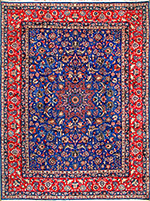Textiles Studies

Textile Research Works
Date of this Version
1989
Document Type
Article
Citation
Exhibition Guide, The Textile Museum, Washington, DC, April 1 - September 17, 1989
Abstract
Oriental carpets have long fascinated the American public. Rich colors and attractive designs, as well as lush pile and renowned durability have given them a well-deserved reputation as beautiful and useful floor-coverings. Handmade products of far distant lands, their complicated patterns also evoke the romance of luxury and the Orient in days of yore. Yet Oriental carpets also represent both social history and manufacturing traditions related to the human needs, economy, and ecological constraints of their cultural origins.
Arthur D. Jenkins, an American collector of Oriental carpets, was intrigued by the social origins of rugs. Early in his collecting career, he decided to focus not on the more familiar and more often commercially produced and marketed Oriental carpets that had graced the parlors and drawing rooms of American micl.dle-class homes. Instead he focused on the lesser-known traditions of tribal and ethnographic peoples of the Near East. The rugs of these peoples have a long history, but have more recently entered the realm of collectibles. Some rugs were produced for the people that wove them, and they were not made for commercial sale. They were worn and well-used, and only rarely available in the markets and bazaars of Cairo, Istanbul, Tblisi and Bokhara. Those that survive today most often were produced in the nineteenth and early twentieth centuries by rural sedentary and nomadic population groups of Anatolia, Persia, the Caucasus and Central Asia, which today fall within the present borders of Turkey, Iran, and southern republics of the Soviet Union. Organized by Carol Bier, curator of Eastern Hemisphere Collections at The Textile Museum, this exhibition, "An Introduction to Oriental Carpets: The Arthur D. Jenkins Collection:' is a back-to-basics presentation, opening new vistas for the novice, and exploring familiar territory in novel ways for the specialist.
Included in
Art and Materials Conservation Commons, Art Practice Commons, Fiber, Textile, and Weaving Arts Commons, Indigenous Studies Commons, Museum Studies Commons


Comments
Copyright © 1989 he Textile Museum